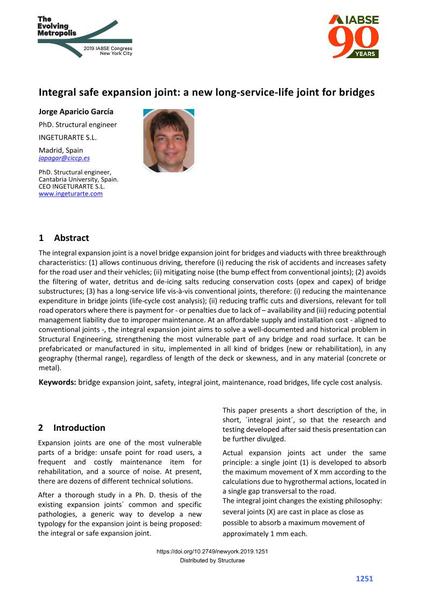Integral safe expansion joint: a new long-service-life joint for bridges

|
|
|||||||||||
Détails bibliographiques
| Auteur(s): |
Jorge Aparicio García
(INGETURARTE S.L.)
|
||||
|---|---|---|---|---|---|
| Médium: | papier de conférence | ||||
| Langue(s): | anglais | ||||
| Conférence: | IABSE Congress: The Evolving Metropolis, New York, NY, USA, 4-6 September 2019 | ||||
| Publié dans: | The Evolving Metropolis | ||||
|
|||||
| Page(s): | 1251-1256 | ||||
| Nombre total de pages (du PDF): | 6 | ||||
| DOI: | 10.2749/newyork.2019.1251 | ||||
| Abstrait: |
The integral expansion joint is a novel bridge expansion joint for bridges and viaducts with three breakthrough characteristics: (1) allows continuous driving, therefore (i) reducing the risk of accidents and increases safety for the road user and their vehicles; (ii) mitigating noise (the bump effect from conventional joints); (2) avoids the filtering of water, detritus and de-icing salts reducing conservation costs (opex and capex) of bridge substructures; (3) has a long-service life vis-à-vis conventional joints, therefore: (i) reducing the maintenance expenditure in bridge joints (life-cycle cost analysis); (ii) reducing traffic cuts and diversions, relevant for toll road operators where there is payment for - or penalties due to lack of – availability and (iii) reducing potential management liability due to improper maintenance. At an affordable supply and installation cost - aligned to conventional joints -, the integral expansion joint aims to solve a well-documented and historical problem in Structural Engineering, strengthening the most vulnerable part of any bridge and road surface. It can be prefabricated or manufactured in situ, implemented in all kind of bridges (new or rehabilitation), in any geography (thermal range), regardless of length of the deck or skewness, and in any material (concrete or metal). |
||||
| Mots-clé: |
ponts-routes
|
||||
